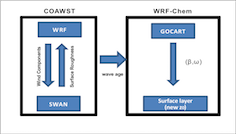WRF-Chem
WRF-Chem is a fully coupled online community model for the prediction and simulation of weather, dispersion, air qual- ity, and regional climate (Grell et al., 2005). The chemistry model has been built to be consistent with the Weather Re- search and Forecasting (WRF, http://www2.mmm.ucar.edu/wrf/users/) modelling package.
Possible applications of the current modelling system concern (i) the prediction and simulation of weather, or regional and local climate; (ii) the re- lease and transport of constituents through coupled weather prediction/dispersion model simulations; (iii) the analysis of the full interaction of chemical species as well as particulate matter through a coupled weather–dispersion–air quality model; and (iv) the study of processes that are important for global climate change issues, including the aerosol direct and indirect forcing.
Coupling algorithm

Transport of natural aerosol in the mediterranean basin
Aerosol particles influence climate by modifying both the global energy budget through absorption and scattering of solar radiation (direct effects), and the interactions with clouds and the development and occurrence of precipitation (indirect effects). Although in situ measurements and satellite- and ground-based remote sensing provide important information regarding aerosol loading, distribution, and influences, such measurements are essentially limited in space and time and, above all, are limited in their ability to distinguish between natural and anthropogenic aerosol components. In this context, assessment of aerosol influences on climate by means of numerical simulations is essential for interpreting past climate and for projecting future changes for different emission scenarios. This assessment requires accurate representation within global/regional models of the physical and chemical properties of the particles that comprise atmospheric aerosols and the processes that influence those properties. Key processes that must be represented include: the emission of primary particles, such as mineral dust, sea salt, black carbon, and organic carbon; dry and wet deposition to the surface and all the processes that are dependent on aerosol microphysics.
Link to special cases study:
- Medicane Salento 2006
- Etna eruption 2015
- Medicane Rolf
- Vaia Storm
- Dust outbreak march 2016
- Calbuco Eruption April 2015 (Chile)
